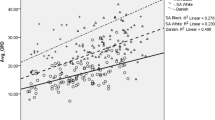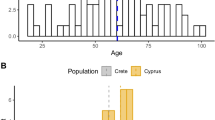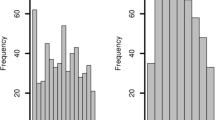Abstract
Various methods are available for estimating age from skeletal remains, amongst them the use of histomorphometry. It is generally argued that age estimation standards are population specific, but this in itself creates problems as the reference samples used are often not large enough and/or lack substantial representation of all age cohorts. Traditional age methods have been shown to suffer from problems such as age mimicry. This paper aims at establishing histological age-at-death standards for the white South African population by supplementing the available sample (lacking an adequate number of young adults) with another sample of European descent to avoid over-estimation of age in younger individuals caused by age mimicry. Bone microstructures related to the number of osteons and fragments, osteon size and Haversian canal size that change with advancing age were used for the development of regression formulae. A histomorphometric assessment of the anterior cortex of the femur was done using stereology for the estimation of age at death. All sections were analysed using the optical fractionator and nucleator probes. A sample of 94 bone sections (n = 50 male, n = 44 females) of white South African individuals were used. A sample of Danish individuals (n = 14 males, n = 16 females) was combined with the South African sample to create a normal age distribution for the reference sample. Single and multiple regression equations were developed after randomly selecting a hold-out sample (n = 14) for validation. Osteon size (average length, surface area and volume) showed the highest correlation with age, followed by the number of osteons and fragments per grid area. Haversian canal size showed inconsistent changes with advancing age. Using the regression equations, predicted ages were obtained for the 14 individuals. RMSE values ranged between 14 and 17 years, which we deemed acceptable.



Similar content being viewed by others
References
Garvin HM, Passalqua NV, Uhl NM, Gipson DR, Overbury RS, Cabo LL (2012) Developments on forensic anthropology: age-at-death estimation. In: Dirkmaat DC (ed) A companion to forensic anthropology. Blackwell Publishing, UK, pp 202–238
Bocquet-Appel JP, Masset C (1982) Farewell to paleodemography. J Hum Evol 11:321–333
Konigsberg LW, Frankenberg SR (1992) Estimation of age structure in anthropological demography. Am J Phys Anthropol 89:235–256
Boldsen JL, Milner GR, Konigsberg JW, Wood JW (2002) Transition analysis: a new method for estimating age from skeletons. In: Hoppa RD, Vaupel JW (eds) Paleodemography: age distributions from skeletal samples. Cambridge University Press, pp 73–106
Cho H, Stout SD, Madsen RW, Streeter MA (2002) Population-specific histological age-estimating method: a model for known African-American and European-American skeletal remains. J Forensic Sci 47:12–18
Cool SM, Hendrikz JK, Wood WB (1995) Microscopic age changes in the human occipital bone. J Forensic Sci 40:789–796
Singh IJ, Gunberg DL (1970) Estimation of age at death in human males from quantitative histology of bone fragments. Am J Phys Anthropol 33:373–382
Drusini A, Businaro F (1990) Skeletal age determination by mandibular histomorphometry. Int J Anthropol 5:235–243
Stout SD, Porro MA, Perotti B (1996) Brief communication: a test and correction of the clavicle method of Stout and Paine for histological age estimation of skeletal remains. Am J Phys Anthropol 100:139–142
Lee U-Y, Jung G-U, Choi S-G, Kim Y-S (2014) Anthropological age estimation with bone histomorphometry from the human clavicle. Anthropologist 17:929–936
Kimura K (1992) Estimation of age at death from second metacarpals. Z Morph Anthropol 79:169–181
Stout SD, Dietze WH, İşcan MY, Loth SR (1994) Estimation of age at death using cortical histomorphometry of the sternal end of the fourth rib. J Forensic Sci 39:778–784
Crowder C, Heinrich J, Stout SD (2012) Rib histomorphometry for adult age estimation. In: Bell LS (ed) Forensic microscopy for skeletal tissues: methods and protocols. Springer Science and Business Media, New York, pp 109–127
Thompson DD (1979) The core technique in the determination of age at death of skeletons. J Forensic Sci 24:902–915
Yoshino M, Imaizumi K, Miyasaka S, Seta S (1994) Histological estimation of age at death using microradiographs of humeral compact bone. Forensic Sci Int 64:191–198
Kerley ER (1965) The microscopic determination of age in human bone. Am J Phys Anthropol 23:149–164
Narasaki S (1990) Estimation of age at death by femoral osteon remodelling: application of Thompson’s core technique to modern Japanese. J Anthropol Soc Nippon 98:29–38
Ericksen MF (1991) Histological estimation of age at death using the anterior cortex of the femur. Am J Phys Anthropol 84:171–179
Watanabe Y, Konishi M, Shimada M, Ohara H, Iwamoto S (1998) Estimation of age from the femur of Japanese cadavers. Forensic Sci Int 98:55–65
Keough N, L’Abbé EN, Steyn M (2009) The evaluation of age-related histomorphometric variables in a cadaver sample of lower socioeconomic status: implications for estimating age at death. Forensic Sci Int 191:114.e1–114.e6
Hauser R, Barres D, Durigon M, Derobert L (1980) Identification par l’histomorphometrie du femur et du tibia. Acta Med Leg Soc 30:91–97
Kerley ER, Ubelaker DH (1978) Revisions in the microscopic method of estimating age at death in human cortical bone. Am J Phys Anthropol 49:545–546
Stout SD, Paine RR (1992) Histological age estimation using rib and clavicle. Am J Phys Anthropol 87:111–115
Robling AG, Stout SD (2008) Histomorphometry of human cortical bone: applications to age estimation. In: Katzenberg MA, Saunders S (eds) Biological anthropology of the human skeleton. Wiley, Hoboken, pp 149–182
Crowder C, Heinrich J, Dominquez V (2009) Histological age estimation. In: Blau S, Ubelaker D (eds) Handbook of forensic anthropology and archaeology. Left Coast Press, Walnut Creek, pp 222–235
Pfeiffer S, Heinrich J, Beresheim A, Alblas M (2016) Cortical bone histomorphometry of known-age skeletons from the Kirsten Collection, Stellenbosch University, South Africa. Am J Phys Anthropol 160:137–147
Black J, Mattson R, Korostoff E (1974) Haversian osteons: size, distribution, internal structure and orientation. J Biomed Mater Res 8:299–319
Pfeiffer S, Crowder C, Harrington L, Brown M (2006) Secondary osteon and Haversian canal dimensions as behavioral indicators. Am J Phys Anthropol 131:460–468
Howard CV, Reed M (2005) Unbiased stereology: three-dimensional measurements in microscopy, 2nd edn. New York, BIOS Scientific Publishers
Botha D, Lynnerup N, Steyn M (submitted) Inter-population variation of histomorphometric variables used in the estimation of age-at-death. Int J Leg Med
L’Abbé EN, Loots M, Meiring JH (2005) The Pretoria bone collection: a modern South African skeletal sample. HOMO – J Comp Hum Biol 56:197–205
Maat GJR, Van den Bos RPM, Aarents MJ (2002) Manual for the preparation of ground sections for the microscopy of bone tissue. Barge’s Anthropologica Nr. 7. Leiden University Medical Centre: Leiden, Netherlands
Villa C, Lynnerup N (2009) A stereological analysis of the cross-sectional variability of the femoral osteon population. Am J Phys Anthropol 142:491–496
West MJ (2012) Introduction to stereology. Cold Spring Harb Protoc 2012:843–851
Botha D, Bhagwandin A, Lynnerup N, Steyn M (2018) The use of stereological methods in the histomorphometric assessment of bone for age-at-death estimation. Forensic Sci Int 290:353.e1–353.e7
West MJ, Slomianka L, Gundersen HJG (1991) Unbiased stereological estimation of the total number of neurons in the subdivisions of the rat hippocampus using the optical fractionator. Anat Rec 231:482–497
Gundersen HJG (1977) Notes on the estimation of the numerical density of arbitrary profiles: the edge effect. J Microsc 111:219–223
Gundersen HJG, Bagger P, Bendtsen S et al (1988) The new stereological tools: disector, fractionator, nucleator and point sampled intercepts and their use in pathological research and diagnosis. APMIS 96:857–881
Seber GAF, Lee AJ (2003) Linear regression analysis, 2nd edn. Hoboken, Wiley
Rankin G, Stokes M (1998) Statistical analysis of reliability studies. Clin Rehab 12:187–199
Maat GJR, Maes A, Aarents MJ, Nagelkerke NJD (2006) Histological age prediction from the femur in a contemporary Dutch sample: the decrease of nonremodeled bone in the anterior cortex. J Forensic Sci 51:230–237
Aykroyd RG, Lucy D, Pollard AM, Solheim T (1997) Technical note: regression analysis in adult age estimation. Am J Phys Anthropol 104:259–265
Acknowledgements
The authors would like to thank the curators of the Pretoria Bone Collection and Raymond A. Dart Skeletal Collection for granting access to the remains, Prof. Paul Manger for use of the stereology system and Dr. A. Bhagwandin for assisting with the production of the stereology images.
Funding
This project received financial support from the National Research Foundation.
Author information
Authors and Affiliations
Corresponding author
Ethics declarations
Conflict of interest
The authors declare they have no conflict of interest.
Statement of informed consent
Ethical approval for the project was obtained through the University of the Witwatersrand.
Additional information
Publisher’s note
Springer Nature remains neutral with regard to jurisdictional claims in published maps and institutional affiliations.
Rights and permissions
About this article
Cite this article
Botha, D., Steyn, M. & Lynnerup, N. Histological age-at-death estimation in white South Africans using stereology. Int J Legal Med 133, 1957–1965 (2019). https://doi.org/10.1007/s00414-019-02152-8
Received:
Accepted:
Published:
Issue Date:
DOI: https://doi.org/10.1007/s00414-019-02152-8




